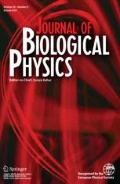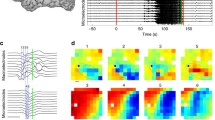Abstract
Nonparametric system modeling constitutes a robust method for the analysis of physiological systems as it can be used to identify nonlinear dynamic input–output relationships and facilitate their description. First- and second-order kernels of hippocampal CA3 pyramidal neurons in an in vitro slice preparation were computed using the Volterra–Wiener approach to investigate system changes associated with epileptogenic low-magnesium/high-potassium (low-Mg2 + /high-K + ) conditions. The principal dynamic modes (PDMs) of neurons were calculated from the first- and second-order kernel estimates in order to characterize changes in neural coding functionality. From our analysis, an increase in nonlinear properties was observed in kernels under low-Mg2 + /high-K + . Furthermore, the PDMs revealed that the sampled hippocampal CA3 neurons were primarily of integrating character and that the contribution of a differentiating mode component was enhanced under low-Mg2 + /high-K + .






Similar content being viewed by others
References
Bragin, A., Mody, I., Wilson, C.L., Engel, J.J.: Local generation of fast ripples in epileptic brain. J. Neurosci. 22, 2012–2021 (2002)
Karnup, S., Stelzer, A.: Seizure-like activity in the disinhibited CA1 minislice of adult guinea-pigs. J. Physiol. 532, 713–730 (2001)
Walther, H., Lambert, J.D., Jones, R.S., Heinemann, U., Hamon, B.: Epileptiform activity in combined slices of the hippocampus, subiculum and entorhinal cortex during perfusion with low magnesium medium. Neurosci. Lett. 69, 156–161 (1986)
Buckmaster, P.S., Zhang, G.F., Yamawaki, R.: Axon sprouting in a model of temporal lobe epilepsy creates a predominantly excitatory feedback circuit. J. Neurosci. 22, 6650–6658 (2002)
McNamara, J.O.: Cellular and molecular basis of epilepsy. J. Neurosci. 14, 3413–3425 (1994)
French, A.S., Marmarelis, V.Z.: Nonlinear analysis of neuronal systems. In: Windhorst, U., Johansson, H. (eds.) Modern Techniques in Neuroscience Research. Springer, New York (1999)
Dimoka, A., Courellis, S.H., Gholmieh, G.I., Marmarelis, V.Z., Berger, T.W.: Modeling the nonlinear properties of the in vitro hippocampal perforant path-dentate system using multielectrode array technology. IEEE Trans. Biomed. Eng. 55, 693–702 (2008)
Dimoka, A., Courellis, S.H., Marmarelis, V.Z., Berger, T.W.: Modeling the nonlinear dynamic interactions of afferent pathways in the dentate gyrus of the hippocampus. Ann. Biomed. Eng. 36, 852–864 (2008)
Naylor, D.: Changes in nonlinear signal processing in rat hippocampus associated with loss of paired-pulse inhibition or epileptogenesis. Epilepsia 43(Suppl 5), 188–193 (2002)
Zhong, Y., Wang, H., Ju, K.H., Jan, K.M., Chon, K.H.: Nonlinear analysis of the separate contributions of autonomic nervous systems to heart rate variability using principal dynamic modes. IEEE Trans. Biomed. Eng. 51, 255–262 (2004)
Marmarelis, V.Z.: Signal transformation and coding in neural systems. IEEE Trans. Biomed. Eng. 36, 15–24 (1989)
Marmarelis, V.Z., Orme, M.E.: Modeling of neural systems by use of neuronal modes. IEEE Trans. Biomed. Eng. 40, 1149–1158 (1993)
Marmarelis, V.Z.: Identification of nonlinear biological systems using Laguerre expansions of kernels. Ann. Biomed. Eng. 21, 573–589 (1993)
Wiener, N.: Nonlinear Problems in Random Theory. Wiley, New York (1958)
Hung, G., Stark, L.: The kernel identification method (1910–1977) – review of theory, calculation, application, and interpretation. Math. Biosci. 37, 135–190 (1977)
Hong, S., Aguera y Arcas, B., Fairhall, A.L.: Single neuron computation: from dynamical system to feature detector. Neural Comput. 19, 3133–3172 (2007)
Bardakjian, B.L., Courville, A., Vigmond, E.J.: Memory of neuronal networks: the white noise approach. In: Proceedings of the IEEE Engineering in Medicine & Biology 18th Annual Conference, Chicago, October 1997
Bardakjian, B.L., Wright, W.N., Valiante, T., Carlen, P.L.: Nonlinear system identification of hippocampal neurons. In: Marmarelis, V.Z. (ed.) Advanced Methods of Physiological System Modeling. Plenum Press, New York (1994)
Vigmond, E.J., Perez Velazquez, J.L., Valiante, T.A., Bardakjian, B.L., Carlen, P.L.: Mechanisms of electrical coupling between pyramidal cells. J. Neurophysiol. 78, 3107–3116 (1997)
Musallam, S., Tomlinson, R.D.: Asymmetric integration recorded from vestibular-only cells in response to position transients. J. Neurophysiol. 88, 2104–2113 (2002)
Jones, L.M., Depireux, D.A., Simons, D.J., Keller, A.: Robust temporal coding in the trigeminal system. Science 304, 1986–1989 (2004)
Bedingham, W., Tatton, W.G.: Kinematic representation of imposed forearm movements by pericruciate neurons (areas 4 and 3a) in the awake cat. J. Neurophysiol. 53, 886–909 (1985)
Nakazawa, K., McHugh, T.J., Wilson, M.A., Tonegawa, S.: NMDA receptors, place cells and hippocampal spatial memory. Nat. Rev. Neurosci. 5, 361–372 (2004)
Urban, N.N., Barrionuevo, G.: Induction of hebbian and non-hebbian mossy fiber long-term potentiation by distinct patterns of high-frequency stimulation. J. Neurosci. 16, 4293–4299 (1996)
Jacobs, J., LeVan, P., Chander, R., Hall, J., Dubeau, F., Gotman, J.: Interictal high-frequency oscillations (80–500 Hz) are an indicator of seizure onset areas independent of spikes in the human epileptic brain. Epilepsia 49, 1893–1907 (2008)
Moschovos, C., Kostopoulos, G., Papatheodoropoulos, C.: Long-term potentiation of high-frequency oscillation and synaptic transmission characterize in vitro NMDA receptor-dependent epileptogenesis in the hippocampus. Neurobiol. Dis. 29, 368–380 (2008)
Mohajer, M.: Nonlinear time series analysis of electrical activity in a slice model of epilepsy. M.Sc. thesis, University of Toronto (1999)
Author information
Authors and Affiliations
Corresponding author
Rights and permissions
About this article
Cite this article
Kang, E.E., Zalay, O.C., Cotic, M. et al. Transformation of neuronal modes associated with low-Mg2 + /high-K + conditions in an in vitro model of epilepsy. J Biol Phys 36, 95–107 (2010). https://doi.org/10.1007/s10867-009-9144-1
Received:
Accepted:
Published:
Issue Date:
DOI: https://doi.org/10.1007/s10867-009-9144-1




